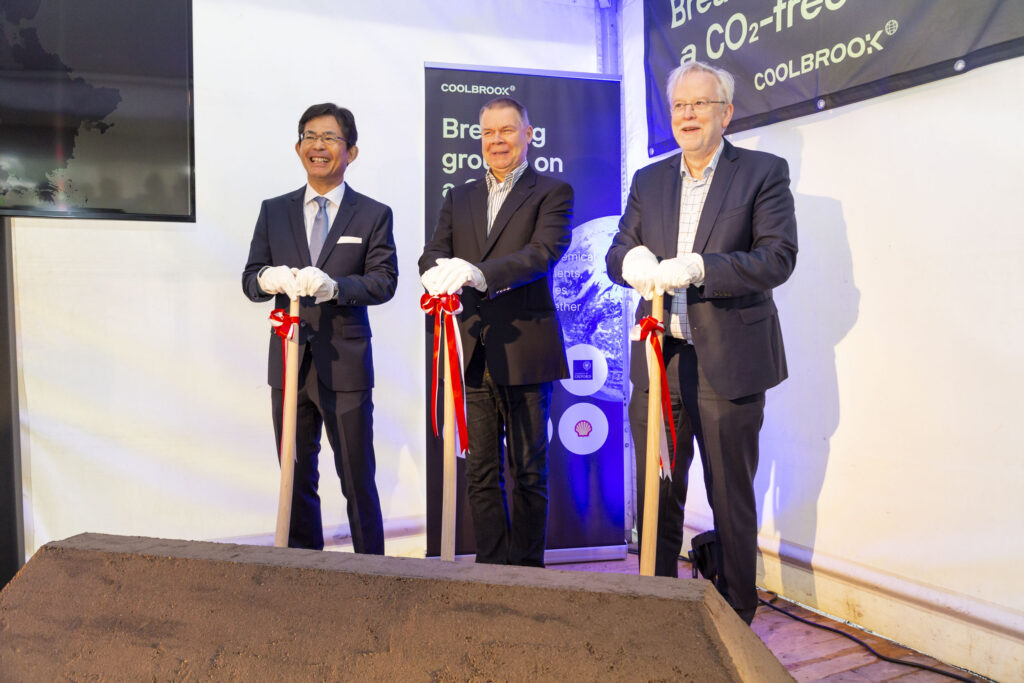Coolbrook Starts Construction of World’s First Sustainable Naphtha Cracker in the Netherlands
Revolutionary pilot aims to reduce CO2 emissions of one of chemical industry’s key processes to zero

From left to right: Masayuki Takinami (Takenaka), Harri Johannesdahl (Coolbrook) en Bert Kip (Brightlands Chemelot Campus) at Coolbrook’s ground breaking ceremony
After announcing the new sustainable cracker this summer, Coolbrook and its partners had the ground-breaking ceremony at Brightlands Chemelot Campus in Netherlands this week. At Chemelot the world’s first electric steam cracker will be tested and further perfected towards commercialisation. The campus is located in the heart of one of the largest chemical clusters in the world: the Antwerp-Rotterdam-Rhein-Ruhr-Area, where major naphtha crackers of companies like SABIC, DOW, Shell, BP, Total, LyondellBasell and BASF are located.
Coolbrook’s sustainable ambitions for the chemical industry
Coolbrook has a mission to create a cleaner, more sustainable and profitable way to produce Olefins, the main component in the petrochemical industry and the production chemical products, construction materials, packaging and more. Chemical cracking is a key chemical process, that lies at the basis of countless products we use. But it is also a process that in its current form inevitably emits a lot of CO2. Worldwide, but also in the Netherlands: Dutch research institute TNO earlier indicated that the cracking furnaces in the Netherlands together emit five million tons of CO2 per year, which is almost 3 percent of the Netherlands’ total annual CO2 emissions.
Coolbrook’s innovative electric cracker in Geleen will make use of Rotor Dynamic Reactor (RDR). This revolutionary technology combines space science, turbomachinery and chemical engineering to replace the current steam cracking methods used to make Olefins with a radically cleaner and more effective alternative. Backed by a growing number of governments, petrochemical producers and environmental regulators, Coolbrook’s RDR technology can solve one of the key technological challenges the industry faces to become CO2 neutral.
Reducing CO2 emissions while using renewable energy sources
For a considerable time, Coolbrook has been working on a sustainable naphtha cracker, which supplies the raw materials for plastics (plastics) such as polyethylene and polypropylene through a petrochemical process. The energy required for this is now mostly generated from fossil fuels. Coolbrook’s innovative Rotor Dynamic Reactor (RDR) technology radically changes this and completely reduces the CO2 emissions of this process while using renewable energy sources.
As part of the preparations for this pilot, air tests will take place in Finland before the end of this year with the revolutionary RDR technology. The pilot at Brightlands Chemelot Campus will be fully operational in April 2022.
Endorsement from chemical industry and government
Coolbrook is signaling a rapidly growing industry interest in this revolutionary technology. Dutch chemical company Shell endorses the value of this technology by joining as an industry partner for the pilot project at Brightlands Chemelot Campus. In addition to the fact that this innovative technology provides up to twenty percent more ethylene yield than a traditional cracker, the contribution to the energy transition and to making traditional industry and plastic production more sustainable is even more important.
Implementation of the RDR technology leads to a complete reduction in CO2 emissions, thirty percent reduction in energy consumption and therefore sixty percent more profit. In July, the technology received over 5.5 million euros in subsidy from the Ministry of Economic Affairs and Climate Change to enable this pilot to be carried out on an industrial scale.
Source: Coolbrook
12 October 2021